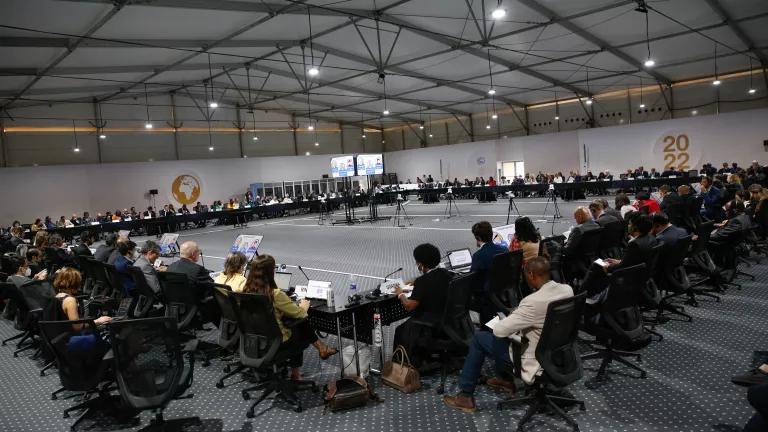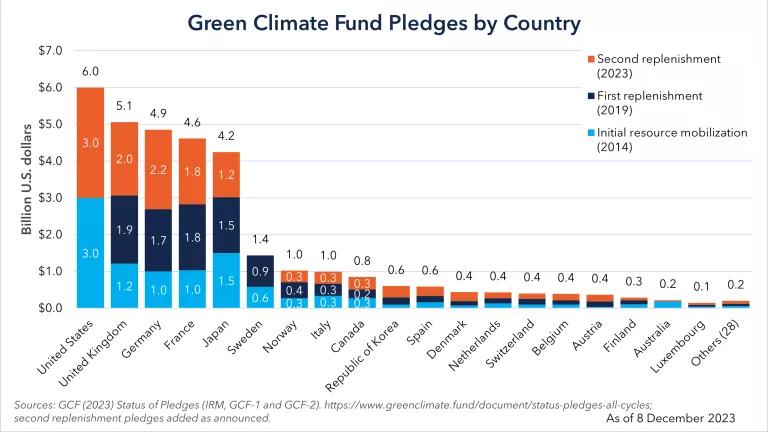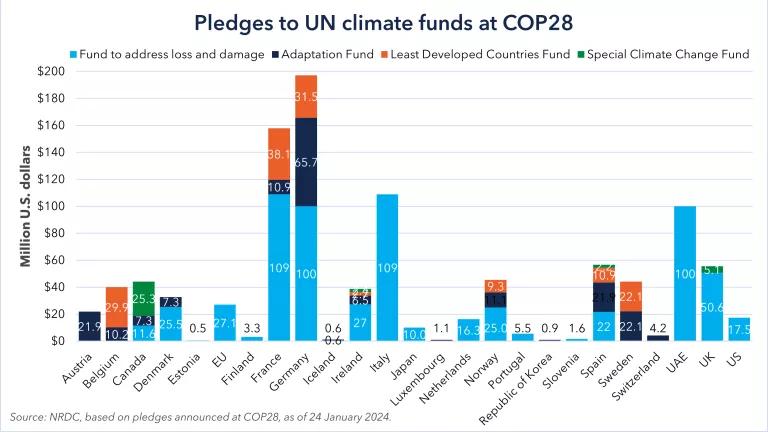What Might the New Global Climate Finance Goal Look Like?
Back in 2015, governments agreed to negotiate a new climate finance goal prior to 2025. What are the key elements that countries need to agree on?

Ministerial dialogue on the new climate finance goal at COP27
UN Climate Change / Kiara Worth CC BY-NC-SA 2.0 Deed
Climate change is a story of injustice. The people and communities who have done the least to cause the problem, and who have the fewest resources to deal with it, are hit first and worst by the impacts.
When governments negotiated the first treaty to address the climate crisis in the early 1990s, they recognized this undeniable reality: wealthier developed countries agreed to take the lead in combating climate change while supporting developing countries with finance, technology and capacity building to support their transition to low-emissions and climate resilient economies.
At the Copenhagen climate summit in 2009, developed countries added a specific dollar pledge: to mobilize $100 billion a year in climate finance for developing countries, from both public and private sources, by 2020 in the context of meaningful mitigation actions and transparency on implementation.
In 2015, as part of the grand bargain that secured the Paris Agreement, developed countries agreed to extend this $100 billion per year mobilization through to 2025. At the same time, governments also agreed to negotiate a new collective quantified goal (or NCQG) prior to 2025. This recognized that more finance is needed to decarbonize and future-proof economies at the pace and scale required by the Paris Agreement.
Negotiations on the new goal began in earnest in 2021, with governments setting a deadline to agree the new goal at the COP29 climate negotiations which will take place this November in Azerbaijan. For the past two years, governments, civil society groups, and researchers have convened for eight technical expert dialogues to share ideas about what the goal should look like, and ministers have met at for a high-level dialogue at the COP each year.
At COP28 in Dubai last December, governments agreed to step things up a notch for the final year of the negotiation process. Alongside continued expert dialogues, negotiators will hold three meetings to begin working on a framework for a draft negotiating text. These sessions will be important to ensure that when governments meet in Baku there are clear options to guide ministers’ decisions, rather than a blank sheet of paper or a long laundry list.
This new goal can play an important role in getting all countries to commit to more ambitious climate action. A goal that sends a clear signal about increased climate investments can give confidence to leaders to commit their countries to stronger emissions reductions targets, and enable them to better deal with climate impacts. This is particularly important since all countries must submit updated nationally determined contributions (NDCs) under the Paris Agreement by February next year.
What are the key elements that countries need to agree on in a new goal? Issues include the quantity of the goal, its structure, quality, who the contributors are, how the new goal relates to the Paris Agreement’s long term finance goal, time frames, process for revision, how to track and review progress. These are complex, contentious, and interrelated topics. To reach an ambitious outcome by COP29 in November it will require technical negotiators to have frank and focused discussions to identify a clear set of options, and needs political leaders to use high-level gatherings to seek common ground on the most contentious areas where technical negotiators can get deadlocked.
Before exploring the key elements one by one, it is important to review lessons from the past.
The previous goal
The $100 billion goal has been a mixed experience. On the one hand, it has elevated focus on international climate finance in helpful ways. The goal has meant developed country governments have come under greater pressure to scale up their climate finance, and they are increasingly prioritizing climate in their overseas financing. Without a formal quantified goal it is not clear that they would have done so.
Yet developed countries failed to hit the $100 billion on time in 2020; based on preliminary and as-yet unreleased projections, they have said they met the goal in 2022.

NRDC/Joe Thwaites
Moreover, the $100 billion goal was not clearly defined. Decisions among the 198 countries that are Parties to UN climate negotiations are agreed by consensus, so often include a degree of constructive ambiguity. But the lack of clarity of what types of funding should count towards the goal and transparency provisions that do not enforce consistent reporting led to widely varying interpretations of how well countries have upheld the bargain, leading to mistrust and acrimony.
Finally, though some studies informed the original target when it was established 15 years ago, $100 billion per year now appears incongruous when compared to the latest much higher estimates of support needed to address the climate crisis.
Negotiating mandates
This brings us to the new goal. While most of the substance is yet to be agreed, governments have taken three key decisions specifying parameters for the new goal (key new mandates in each decision in bold):
53. […] prior to 2025 the Conference of the Parties serving as the meeting of the Parties to the Paris Agreement shall set a new collective quantified goal from a floor of USD 100 billion per year, taking into account the needs and priorities of developing countries”
Decision 1/CP.21 (2015)
1. Decides to initiate at its third session (November 2020), in accordance with Article 9, paragraph 3, of the Paris Agreement, deliberations on setting a new collective quantified goal from a floor of USD 100 billion per year in the context of meaningful mitigation actions and transparency of implementation and taking into account the needs and priorities of developing countries;
2. Agrees to consider, in its deliberations referred to in paragraph 1 above, the aim to strengthen the global response to the threat of climate change in the context of sustainable development and efforts to eradicate poverty, including by making finance flows consistent with a pathway towards low greenhouse gas emissions and climate-resilient development
Decision 14/CMA.1 (2018)
15. Decides that the new collective quantified goal aims at contributing to accelerating the achievement of Article 2 of the Paris Agreement of holding the increase in the global average temperature to well below 2 °C above pre-industrial levels and pursuing efforts to limit the temperature increase to 1.5 °C above pre-industrial levels, recognizing that this would significantly reduce the risks and impacts of climate change; increasing the ability to adapt to the adverse impacts of climate change and foster climate resilience and low greenhouse gas emission development in a manner that does not threaten food production; and making finance flows consistent with a pathway towards low greenhouse gas emission and climate-resilient development;
16. Also decides that the consideration of the new collective quantified goal will be in line with decision 14/CMA.1 and take into account the needs and priorities of developing countries and include, inter alia, quantity, quality, scope and access features, as well as sources of funding, of the goal and transparency arrangements to track progress towards achievement of the goal, without prejudice to other elements that will also be considered as the deliberations evolve and taking into consideration the submissions referred to in paragraphs 17–18 below
Decision 9/CMA.3 (2021)
Elements of the new goal
Based on these mandates, over the past two years governments have used the technical expert dialogues and annual climate negotiations to discuss what the goal should look like, with the co-chairs of the process compiling a longlist of potential options for elements of the new goal.
Over the next seven months, country negotiators will need to make progress in paring down options so that at COP29 ministers can focus on the key political decisions.
Here are some of the key questions to be resolved, drawing on insights from the $100 billion experience:
Quantity
The new goal must be above $100 billion per year and take into account the needs and priorities of developing countries. Needs estimates from both bottom-up assessments and top-down modelling find that total global climate investment needs run to multiple trillions of dollars per year. Some countries have suggested presenting the goal as a percentage of gross domestic product or gross national income, rather than in dollars, and others have raised the idea of measuring the goal in terms of achieved outcomes, such as emissions reductions and increased resilience to climate impacts. A key question is how to break down overall needs estimates: how much should be public finance and how much private, what portion should be met through international funding and what portion domestically? These questions are both technical and political, touching on debates around the most effective mix of market and planned economies, equity principles, and national circumstances. Approaches for how to connect overall climate finance needs assessments to particular sources of funding could help negotiations.
Structure
The $100 billion was a singular numerical goal that incorporated multiple components: mitigation and adaptation, public and mobilized private sources, bilateral and multilateral delivery channels, and a wide array of financial instruments. This made tracking progress and finding a suitable balance among each of these sub-components challenging. A number of countries have therefore suggested the new goal incorporate sub-targets, and potentially have a layered approach, with smaller targets nested within larger targets. Governments will need to decide what sub-targets and layers could be. They could include thematic targets such as for adaptation, mitigation, and loss and damage; sources of finance such as public, private finance mobilized, and innovative sources; and geographical scope, such as international flows, domestic resource mobilization, and global totals.
Quality
The $100 billion commitment didn’t say much about qualitative elements, such as the types of financial instruments that could be used or the ways countries should be able to access the funding. Many climate vulnerable countries are struggling with sovereign debt crises – many exacerbated by mounting climate impacts – and face significant hurdles in accessing affordable climate finance. A number of governments have therefore argued that the new goal should include qualitative elements, such as principles for funding, targets for improved access, and inclusion of marginalized groups. Some quality criteria could be partially expressed in quantified terms too, such as targets for grant-based finance or allocations for particularly vulnerable countries.
Contributors
The $100 billion commitment was for developed countries to mobilize finance for developing countries. The terms “developed countries” and “developing countries” have never been explicitly defined under the UN Framework Convention on Climate Change, but 39 countries have joined in reporting on how they are delivering the $100 billion goal. These countries have contributed about half of cumulative emissions in the atmosphere and hold a large share of global wealth, so have a significant responsibility for the climate crisis and capacity to provide support. The mandate for the new goal does not specify which countries will be responsible for delivering it; governments will need to define the contributor base. Developed countries have argued that since a number of other countries now have similar or higher levels of wealth and emissions (whether measured in aggregate or per capita terms), these countries should join them in contributing to the new goal. This could include different sets of countries contributing in different ways to different elements of the goal. Some governments have also argued that the goal should include funding from the private sector and innovative sources of finance, such as levies on shipping and aviation. A key question is who would be held accountable for contributions from these sources, given that the goal is being negotiated by sovereign states, and non-state entities would not be formal Parties to the commitment.
Relationship to the Paris Agreement’s long-term goal on finance
The $100 billion goal pre-dated the Paris Agreement, and focused solely on mobilization of finance by developed countries for developing countries. The 2015 Paris Agreement included, as one of its three long-term goals, Article 2.1c which aims at “making finance flows consistent with a pathway towards low greenhouse gas emissions and climate-resilient development.” This was significant, since it was the first time UN climate negotiations set a finance goal reflecting the full scale of effort needed to address climate change; incorporating public, private, domestic and international financial flows. Article 2.1c also looks beyond just scaling up climate-positive finance to the imperative to phase out financing for activities that are incompatible with climate goals, such as fossil fuels. The mandates for the new goal instruct negotiators that the aim of the goal is to contribute to accelerating the achievement of Article 2 of the Paris Agreement, including the 2.1c finance goal. A key question will therefore be how the new quantified goal connects to the long-term goal. This could be by having elements of the new goal that address broader alignment of finance flows, such as reforming fossil fuel subsidies, or connecting quantified targets for provision and mobilization of international climate finance to the broader global transition to net zero and resilient economies.
Time frames and revision
Developed countries had over a decade between agreeing to the $100 billion goal and needing to reach the target, and the commitment runs for six years, from 2020 to 2025. The new goal must be agreed “prior to 2025”, but the time frame it will cover has not been set. Governments have suggested various options, including five years (the same frequency as NDC submissions and Global Stocktakes under the Paris Agreement), 10 years, and 25 years (i.e. 2050, when the world needs to reach net zero emissions). Some countries have suggested a combination of a long-term target and interim targets. Related to time frames is the question of whether and how the goal would be revised over time. Given how long the current negotiations on the goal have taken (nine years between the mandate being established and the scheduled conclusion, and three years of actual negotiations) the frequency, criteria and process for revisions will be key questions to answer.
Tracking and reviewing progress
The quality and consistency of climate finance reporting has been one of the big challenges in assessing progress towards the $100 billion goal. A new system for how countries report on efforts under the Paris Agreement comes into effect this year. For the first time, all countries will report every two years using the same guidelines. This new process can hopefully lead to an improvement in the consistency and quality of climate finance reporting. Nonetheless, some countries have suggested the need for revisions to these rules in light of the new goal (the reporting guidelines are in any case up for review in 2028), and others suggested creating other reporting and tracking systems for the goal, with potentially more frequent reporting. New systems could also include tasking an independent entity that has the trust of all countries to assess progress towards the goal.
This is by no means a comprehensive list and is just an overview of key debates on each issue; we will be diving deeper into these questions and our recommendations in future pieces.
Next steps
It is critical that negotiators be willing to have frank and focused discussions on the key elements of the goal at the three technical meetings this year, and identify a pared down set of options that can be incorporated into the framework for a draft negotiating text. For more contentious areas where technical negotiators can get stuck, government leaders must provide political guidance. Ministers will be meeting in the third quarter of 2024 for a high-level ministerial dialogue, but before then there will be numerous other venues, including the Petersberg Climate Dialogue, G7, G20, and UN General Assembly where heads of state and ministers will have critical opportunities to find common ground.
Preparation is the key to success. While the new climate finance goal undoubtedly touches on topics that are particularly sensitive for governments in a year where over half the world’s population will be going to the polls, putting off discussion of the issues is unlikely to lead to a high-ambition outcome at COP29. Governments need to engage openly, explaining their needs and constraints, and seek common ground for a clear, ambitious, and deliverable goal that empowers all countries to do more to tackle the climate crisis.



